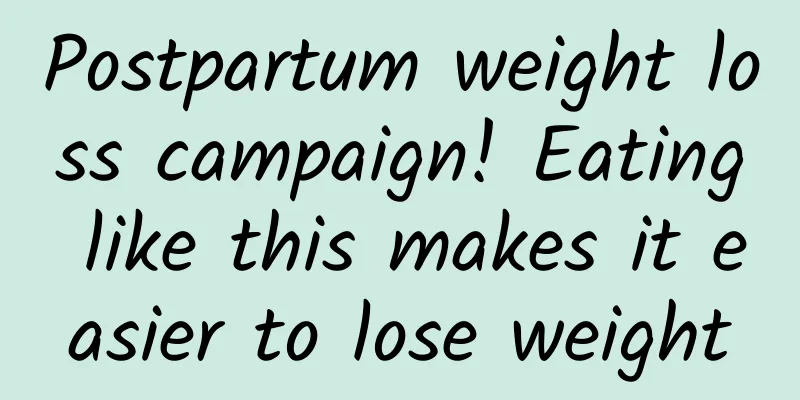Postpartum weight loss campaign! Eating like this makes it easier to lose weight

|
Summer is officially here! You should be welcoming summer with sunshine, beaches and bikinis, but are you giving up because of too much fat on your body? Whether you are a part-time or full-time mother, you usually have almost no extra time for exercise and fitness. What should you do at this time? Postpartum weight loss focus: A loose and enlarged belly is not just fat accumulation Muscle Mom shared that she had participated in a gynecological and obstetrics medical seminar, and the research pointed out that when tracking women after childbirth began, 75% of the mothers' pelvic floor muscles and core muscles had not recovered in the 12 years of the survey. It is also said that many mothers find it difficult to control their urination after giving birth, and may easily leak urine just by laughing or sneezing. In addition, preventing stretch marks before childbirth and losing belly fat after childbirth are both related to the body's muscle condition, not just because of fat accumulation due to eating too much before childbirth. Because exercise can make muscles more elastic and stronger, and the ligaments, tendons and fascia will also become stronger with exercise. The soft tissues in the muscles will become stronger and less likely to break, making it less likely to have stretch marks and speeding up the process of making the belly smoother. 15 minutes of exercise a day makes it easier to lose weight Although the muscular mother continued to control her weight through diet during pregnancy, she still gained 6 kilograms after giving birth. Due to her long-term lack of exercise habits, her recovery speed after giving birth gradually slowed down. Therefore, according to the advice of obstetricians and gynecologists, you can start exercising about 4-6 weeks after a natural birth, or about 3 months after a caesarean section. Doing simple exercises for 15 minutes a day can gradually make your muscles stronger. Not only will you lose weight faster, but you can also improve postpartum urinary incontinence. The difference between postpartum weight loss and general weight loss The main difference is that general weight loss requires a lot of whole-body exercise to reduce fat. The belly looks particularly big because too much fat has accumulated around the body, thus accumulating fat around the organs and abdomen. At this time, you must control your diet and combine it with whole-body exercise. Consuming a large amount of calories can effectively reduce excess fat. But it is different for postpartum mothers. The most common problem they encounter is that even if they do a lot of exercise, it is still difficult to lose weight in the belly, because in addition to fat accumulation, they also need to check whether the abdominal straightness has recovered? The rectus abdominis is a muscle on the surface of the body. There is a linea alba in the middle of the rectus abdominis. During pregnancy, as the uterus nurtures the baby, the linea alba is stretched day by day as the baby grows, and naturally the rectus abdominis is also stretched. After a full week of pregnancy, the baby is gone, but the stretched rectus abdominis muscles cannot go back to their original shape, and the two rectus abdominis muscles will become ring-shaped. If mothers have no previous exercise habits, the recovery of muscles and ligaments will not be very good. Therefore, most mothers still have separated rectus abdominis muscles after delivery. Doing any exercise at this time may not only cause back pain, but also the sagging abdominal muscles may not be able to recover to the state before pregnancy. Rectus abdominis separation examination, you can do it at home while lying down The belly will not become flat automatically after childbirth, so before exercising, you should first do a rectus abdominis separation check, and this check can be done by yourself at home. Sit down with your feet shoulder-width apart, then lie down with your legs bent. Take a deep breath and exhale while curling up your upper body slightly. Use your fingers to touch the separation of the linea alba between the ribs and the navel.
Generally speaking, postpartum mothers can help the rectus abdominis muscles to recombine through exercise, but if the rectus abdominis separation is too severe, it is recommended to seek help from an obstetrician and gynecologist. Postpartum slimming preparatory class, abdominal breathing training during confinement Most people are told by their elders to nourish their bodies and drink more soups and watery foods during the confinement period so that they can produce enough breast milk. But in fact, Muscular Mom recommends that you can start practicing abdominal breathing to awaken your core muscles during the confinement period.
Abdominal breathing can awaken the deep abdominal muscles. You can practice this movement repeatedly during the confinement period. The action is to cross your hands and hug the sides of your ribs, inhale, keep your shoulders still, and feel the ribs pushed to the sides. Once you have no problems, you should also be able to feel your chest and back expanding forward and backward when you inhale. Practice 360-degree breathing through the above three movements, so that when you inhale you can feel your pelvis and ribs being pushed back and forth, left and right, to induce the pelvic floor muscles and diaphragm to start working. This can also avoid overuse of the superficial muscles, which can easily lead to uncomfortable symptoms. It can also avoid movement stagnation caused by discomfort. Postpartum weight loss required credits core muscles awaken again After the confinement period is over and you have confirmed with your obstetrician and gynecologist that you can exercise normally, you can officially embark on the road to weight loss. Muscle Mama also provides you with bodyweight training exercises that you can do at home. 【Core muscle training Part A】
【Core Muscle Training Part B】
【Core Muscle Training Part C】 1. Lift both feet 1 cm off the ground and practice extending and retracting one leg. If both feet are off the ground at the same time, it will cause increased pressure on the back, and the body cannot bear it, but do not force the exercise. The above core muscle exercises cannot be rushed and need to be done step by step. When mothers are familiar with this training, they can combine it with other exercises such as plank exercises, crunches, etc., which can train the muscles from the inside out, help exercise the transverse abdominal muscles, and also help the rectus abdominis recover. Four key points of postpartum diet: consume 500 more calories + supplement calcium! First of all, breastfeeding mothers are advised to consume 500 calories more per day, because every 100 ml of breast milk secreted consumes 60-70 calories. On average, 500 calories more must be supplemented every day. This can also prevent muscle and weight loss too fast, and the basal metabolic rate will also decrease. The next step is calcium supplementation, because during breastfeeding, calcium is not only used by the mother, but the baby also needs calcium supplementation. Therefore, you need to supplement 200g-500g of calcium every day, about 2 cups of dairy products, or consume more foods with high calcium content such as dried tofu and amaranth. Third, you need to maintain a daily intake of 30g of dietary fiber , because dietary fiber plays a very important role in maintaining a sense of fullness. Eating 3 bowls of 80% full vegetables every day can take in 12g of dietary fiber, and 2 fist-sized high-fiber fruits can also take in 10g-12g of dietary fiber. Finally, with 1.5 bowls of whole grains, brown rice, and oatmeal, you can eat about 12g of dietary fiber. It is not necessary to consume 30g of dietary fiber a day. Fourth, be sure to drink water. Whether you are a postpartum mother or a general weight loss expert, you must remember to drink "body weight x 40ml" of water every day to maintain normal daily metabolism. In addition, if you sweat during exercise, you must remember to drink more water to avoid dehydration. Finally, you need to supplement high-quality protein and complex carbohydrates, because supplementing protein after exercise can help muscles recover. Supplementing with complex carbohydrates such as sweet potatoes, brown rice, and whole grains can stimulate insulin secretion, prevent excessive muscle loss, and at the same time maintain sufficient energy in the body to grow muscle, increase the metabolic rate, and lose weight faster. |
Recommend
What happened to my first menstrual period after 10 days?
What happened if I got my period for the first ti...
Can I take Chinese medicine for threatened abortion?
Nowadays, many young people do not know as much a...
What are the symptoms of adnexitis?
Adnexitis is a common type of gynecological infla...
What can I eat to shrink my uterine fibroids? What can I eat to make my uterine fibroids bigger?
What can I eat to shrink my uterine fibroids? Wha...
Will the stomach hurt a lot after medical abortion? These symptoms will appear after medical abortion
Medical abortion can cause the uterine vesicle to...
This is how you get a graceful figure! Ji Hyo runs with perfect curves
[Key points]: As the ace of "Running Man&quo...
Prolactin and Hyperprolactinemia
Symptoms of hyperprolactinemia include breast pai...
What should patients with uterine fibroids pay attention to in their diet?
What should be paid attention to in the diet of u...
Eat at convenience stores every day and follow the dietitian's diet plan without gaining weight
Busy office workers are forced to eat like "...
Does ovarian cyst cause ovulation? What are the symptoms?
Will ovarian cysts cause ovulation? What are the ...
What are the hazards of chronic cervicitis in women? If chronic cervicitis in women is not treated in time, be careful of these hazards
Chronic cervicitis is a disease that seriously ha...
What are the early symptoms of abnormal leucorrhea?
Early symptoms of abnormal vaginal discharge may ...
How to confirm that it is not an ectopic pregnancy
Go to the hospital for B-ultrasound examination t...
How to prevent complications after abortion
How to prevent complications after artificial abo...
Patients with ovarian cysts should eat more alkaline foods
When patients with ovarian cysts actively coopera...









